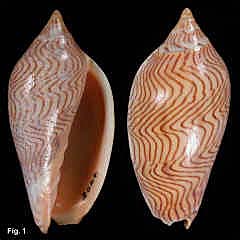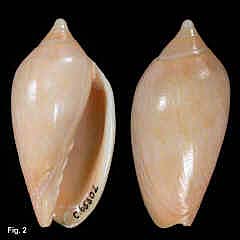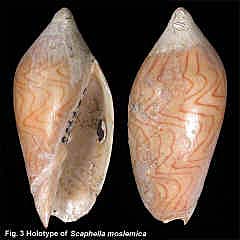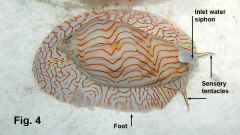|
|
|
|
|
Amoria undulata (Lamarck, 1804) Description: Shell smooth and solid, roundly shouldered. Columella with four strong plaits. Outer lip smooth, thickened in adults. Base colour fawn, marked with thin, dark brown axial lines in a wavy or zigzag pattern. Aperture salmon to orange in colour. Size: Adults 44-121 mm in length, typically 80-90 mm. Distribution: Endemic to Australia: Cape Moreton, Queensland, around southern Australia to Onslow/Dampier region, WA, but with gaps in the distribution (see below). Habitat: In sand, intertidally to 503 metres deep. In South Australia and Victoria this species can be found intertidally, but in NSW it is only found below about 10 metres. Common. Synonymy: Some of the colour forms were specifically named: angasi Sowerby, 1864 is based on South Australian shells with a white background; sclateri Cox, 1869 is based on albino shells with no pattern (Fig. 2); kingi Cox, 1871 has a faint, widely spaced pattern, intermediate between the normal form and the albino form; australiae Cox, 1872 has thick, interrupted lines. Scaphella moslemica Hedley, 1912 is based on a deep-water form from 250 fathoms (457 m) off Sydney. Hedley said it differs from the normal form by having a smaller, thinner shell, smaller protoconch (although this is not apparent in the type), spire covered with opaque white callus, and a lighter pattern (Fig. 3). Remarks: This species is discussed and illustrated in detail by Bail & Limpus (2001). They report that the range is discontinuous; there is a continuous distribution from Cape Moreton in Queensland to Bass Strait and Tasmania, then a gap from Port Phillip Bay to Kangaroo Island, SA. Thence it occurs along the Great Australian Bight to south-western WA, with another gap to an isolated population in the Onslow/Dampier region of WA. Throughout the range there is a variation in size, and shell shape, with the colour pattern varying from the typical lined pattern to white and uncoloured. In South Australia, this species migrates in the spring from deep water to shallow water sandbanks to breed (Smith, Black & Shepherd 1989). It lays egg masses in the shape of a hollow cylinder, 16 to 20 mm in diameter, attached to the substrate. Eggs are contained in capsules in the egg mass, and embryos can be seen through the walls. The embryos hatch as well developed, crawling juveniles. Fig. 1 Normal pattern; off Sydney, about 30 fathoms (55 m) (DLB2044) Fig. 2 sclateri form; off Newcastle Bight, 46 m (C.065302) Fig. 3 Holotype of Scaphella moslemica Hedley, 1912; 23 miles east of Sydney, NSW, 250 fathoms (457 metres) (C.024455) Fig. 4 Animal and shell. Rapid Bay jetty, SA. Photo: Simon Wilson Copyright: Simon Wilson |



